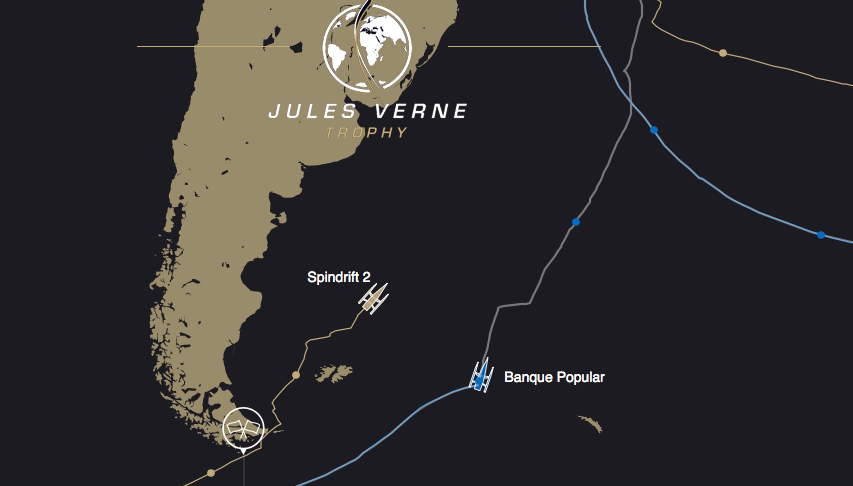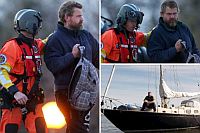I assembled this a few years ago because even I forget some of the boats and events I sailed. Still fond memories; and still making more.
Category: safety at sea
RACING THE GHOST DAY 32

Nursing a boat around the world is no mean feat. Idec with it’s smaller rig may be better suited to resisting this kind of damage.
Any big Trimaran going around the world it is more about slowing down and finishing than pedal to the metal.
AN UPDATE ON THE RESCUE OF LOUIS JORDAN
I, like many people were skeptical of the story as first reported. there may be still more to come. Here are some corrections to the original story.
Louis Jordan — Drifting Sailor Update : Media Misreports Story, Now Reports that Skeptics Doubt Sailor
 This would be funny, if it weren’t sad. Last week the German container ship, Houston Express, picked up Louis Jordan, who had been drifting off Cape Hatteras for a reported 66 days in his dis-masted Alberg 35 sailboat, Angel. The media managed to completely garble the story, to the extent that anyone who took the reporting at face value might not believe what they were reading. Some have suggested that Jordan lied about the whole affair. Last Friday we attempted the untangle the various accounts. See our post: Louis Jordan, Sixty Six Days Adrift — What Really Happened?
This would be funny, if it weren’t sad. Last week the German container ship, Houston Express, picked up Louis Jordan, who had been drifting off Cape Hatteras for a reported 66 days in his dis-masted Alberg 35 sailboat, Angel. The media managed to completely garble the story, to the extent that anyone who took the reporting at face value might not believe what they were reading. Some have suggested that Jordan lied about the whole affair. Last Friday we attempted the untangle the various accounts. See our post: Louis Jordan, Sixty Six Days Adrift — What Really Happened?
Here is where it gets at least slightly funny. This morning the Washington Post published an article with the headline: Why skeptics think a South Carolina sailor lied about being lost at sea for 66 days. The short answer about why anyone might think such a thing could be that they read nonsense in the Washington Post. (To be fair, many, many other news sources didn’t do any better.)
Even three days after the initial reports came in, the Washington Post is still reporting the same false information. In this morning’s article they reported:
Jordan’s saga began Jan. 23, when he set sail from the marina in Conway, S.C., on a short fishing trip. He was reported missing six days later. A German tanker spotted him sitting atop his 35-foot-boat’s overturned hull 200 miles off the North Carolina coast on Thursday, a full 66 days after his disappearance.
There are several things wrong with these statements. First, even though some reporters think all ships are “tankers,” Jordan was picked up by a container ship. This is not an important point, but it does suggest that the writer is either uninformed or sloppy.
The larger point is the claim that Jordan was “spotted … sitting atop his 35-foot-boat’s overturned hull.” The statement is simply wrong. Both the ship’s captain and representatives of the Coast Guard say that the boat was floating upright when found. Beyond that, the claim itself is also impossible.
Jordan’s boat, Angel, was an Alberg 35, a fiberglass cruising sailboat built in the 1960s. It has 5300 lbs. of ballast, a heavy weight in the keel to help keep the boat upright. In fact, over 40% of the entire weight of the boat is ballast. If an Alberg 35 is rolled over, one of two things can happen. If the hatches are open, it can fill with water and sink. If the hatches are closed and the boat doesn’t fill with water, it will right itself. It will roll back up. The boat cannot float upside down. The 5,300 lbs. of ballast in the very bottom of the boat prevents that from happening. So, it was absolutely impossible that Jordan was found “sitting atop his 35-foot-boat’s overturned hull,” as reported by many sources, including the Washington Post. The New York Times version was even more dramatic. They report that Jordan was “clinging to the hull of his overturned sailboat, surviving on raw fish and rainwater.”
Where did this story come from? It appears that a Coast Guard rescue technician, Petty Officer Kyle McCollum, who helped retrieve Jordan the container ship may have misunderstood what he was told by the Germans on the ship. The Coast Guard did not rescue Jordan from his boat. They only picked him off the deck of container ship. It is unclear whether or not the Coast Guard ever saw Jordan’s boat.
Jordan never said that he was “clinging to the hull of his overturned sailboat.” He says that when the boat capsized, he was sleeping below deck. When the boat righted itself, he had to bail out water that had made its way below.
Likewise the captain of the container ship Houston Express, Thomas Grenz, reports that the boat was floating upright when found. The same was said by Coast Guard spokesperson Lt. Krystyn Pecora.
The Washington Post goes on to write:
Even stranger, doubters pointed out, was his skin, which looked pale and unblemished, with only the slightest hint of sunburn, according to the Daily Mail.
“We were expecting worse with blisters and severe sunburn and dehydration,” Petty Officer 3rd Class Kyle McCollum, who had the first contact with the sailor, told the AP.
Once again, it appears that the petty officer’s misunderstanding of the situation was taken at face value. If he believed that Jordan had been “clinging to the hull of his overturned sailboat, surviving on raw fish and rainwater,” then his expectations made sense. As his assumptions were wrong, so were his expectations.
It is also worth noting that Jordan lived on the sailboat before making his ill-advised advised winter fishing trip. The boat was literally his home. As such, it is likely to have had a certain amount of food and water aboard, as well as clothes, tools and other equipment. Jordan was not sitting exposed to the sun and wind for 66 days. He had the shelter of the cabin and at least some some supplies. When his food and water ran low he caught fish and rain water to sustain him. This is not to say that Jordan had it easy. Depending on which news source you read, Jordan lost between 50 and 90 pounds during the 66 day ordeal.
That Jordan had some supplies and shelter was confirmed by the Coast Guard’s Lt. Pecora, who said that he survived eating the food he had on his boat, by collecting rain water and using a net to catch fish. She said Jordan managed to stay hydrated by going inside his boat’s cabin a lot. A report by the LA Times mentions Jordan cooking pancakes on a propane stove.
The Washington Post also questioned Jordan’s injuries. They quoted Erik Kulik of the True North Wilderness Survival School : “He says he broke his right shoulder, and yet he didn’t even seem to be guarding that shoulder in the pictures I saw after the rescue. There is a lot that doesn’t add up.”
Jordan said that he broke his right shoulder, then later corrected himself and said he broke his collar bone. (In an online video, he shows the mark from the break which is on his collarbone near his right shoulder.) A collarbone fracture typically takes two to four weeks to heal. Jordan was missing for 9 weeks so it is not surprising that he had regained mobility in his right arm and shoulder.
There are many questions to be answered about what happened to Louis Jordan. His decision to go fishing in the Gulf Stream in the winter despite hearing the prediction on oncoming storms, suggests that he is “an inexperienced sailor,” as even he describes himself. Reckless and foolhardy are other adjectives which also come to mind. Nevertheless, so far we have seen no evidence that he is a liar.
On the other hand, the reporting on Louis Jordan by the Washington Post, the New York Times, the Guardian, the Daily Mail and seemingly countless others has been a bad joke.
THE REPORT ABOUT THE TEAM VESTAS GROUNDING
click: HERE FOR THE FULL REPORT
This is perhaps the most complete and interesting document. What jumps out at me is the part about digital charts. I have had a number of conversations over the last 10 years about the accuracy of digital charts. And the description of the consequences of a crash jybe. ( which is encouraged by the quick stop rescue system)
In the end an abundance of caution, which might be classified as seamanship.
COAST GUARD RESCUE
Anyone who has been watching the weather knows that February has been an “Epic” month in the Northeast. The loss of the “Bounty” comes to mind; where the skipper thought he could outrun a hurricane in a boat capable of 6 knots in the best of conditions.
The first question is perhaps: who would leave given the weather forecast? The same question for the “Bounty”.
SAILING THROUGH LIFE
This is in response to those who asked:”Who are you?” It is a least a dimension.Boats have always been a part of my life. Naturally interwoven with the story of Newport.
SEAMANSHIP AT SEA
June 25, 2014
All Possible Assistance: A Classic Escorts a Competitor to Safety
Black Watch is hard to slow down, but she had to do it during her unusual assignment in the 2014 Bermuda Race. (Daniel Forster/PPL)
By John Rousmaniere and Chris Museler
Hamilton, Bermuda, June 25. With their big fleets, Newport Bermuda Races usually have a few retirements. This year is no exception, with 10 teams dropping out mostly due to relatively small but nagging gear failures, constraints on the crew’s schedule, or (to quote one competitor) “lack of forward progress.” But also this year, a threat of serious damage led to an extraordinary response.
Halfway into the race, the bottom bearing of the rudder broke on the Taylor 41 Wandrian, a Class 3 entry hailing from Halifax, Nova Scotia, and sailed by Bill Tucker and eight other Canadian sailors. Tucker put a secondary “dam” in place to hold out the water. The crew cut out the bottom of a bailing bucket, split the remaining bucket in two, secured the two pieces around the rudder post with 4200 adhesive, finished off the dam with silicone to fill remaining the cracks and holes—and crossed their fingers. The fiberglass tube holding the post might well shake so badly that it would crack wide open.
Taylor succinctly described the danger after the boat pulled up to the RBYC pier on Wednesday morning: “Our challenge was this: if the rudder post broke, we’d have a 6-inch hole in the bottom of the boat.” All this 300 miles from the nearest shore.
Deciding to continue on to Bermuda and request assistance from another vessel, Tucker made calls over VHF radio at 12:30 p.m. EDT this past Sunday, June 22. Due to a weak connection, the transmission was not ideal, but his message was heard by Rocket Science, a Class 4 entry owned and sailed by Rick Oricchio. He then established a radio watch to check in regularly with Wandrian, and got in touch with the race’s Fleet Communications Office. Based in a room in the New York Yacht Club in Newport, and chaired by Newport Bermuda Race Communications Officer Chris McNally, the FCO maintains a continuous 24-hour watch on the race until after the last boat finishes, using radio and the race tracker.
Her details epitomize integrity. (John Rousmaniere)
As the FCO learned of Wandrian’s problems on Sunday afternoon, so did the crews of two other boats less than 5 miles away. They happened to be two classic wooden yachts designed by Sparkman & Stephens: the 68-foot 1938 yawl Black Watch, commanded by John Melvin; and the 52-foot 1930 yawl Dorade, whose owner and skipper is Matt Brooks.
Black Watch’s afterguard—Melvin, navigator Peter Rugg, and watch captains Lars Forsberg and Jamie Cummiskey—decided that their larger vessel was best qualified to stand by and escort Wandrian to Bermuda. “If the boat has to be evacuated and someone else needs to take eight or nine people aboard, we should be there,” Rugg later explained. “This is the stuff that’s important to the sport.” Added Melvin, “Dorade came over when we came over, and we decided we were the better platform to take people off.” The decision to render all possible assistance to another vessel in difficulty came easily for Melvin, who well understood Wandrian’s situation: “I sailed a little Concordia yawl for a long time and I know what it’s like to have everybody pass you and leave you alone.”
Dorade continued racing while her big cousin began the voyage in her new role as Wandrian’s shadow. The two crews engaged in hourly radio communications, with regular reports to the race Fleet Communications Office. Meanwhile, Black Watch’s sailors wrestled with an unfamiliar seamanship problem: how to sail slowly enough to shepherd a smaller boat. “In a good breeze, we can easily do 9 knots, even in rough water,” Rugg said after they reached Bermuda. “We spent a lot of time figuring out how to sail near her. We kept putting sails up and taking them down.”
Back from the sea, Wandrian is also back to normal as she waits to be hauled in Bermuda. (Chris Museler)
Experimenting with sail combinations, they settled on a full or reefed mainsail, the mizzen, and a forestaysail that could be trimmed to windward to slow the boat by heaving-to. The crew also employed the abrupt slowing maneuver called the “Crazy Ivan,” made famous by the film The Hunt for Red October. In the frequent calms, the two boats doused headsails and turned on engines. The sight of two such different sailing yachts powering side by side so far out in the ocean befuddled their competitors.
This shepherd-and-sheep relationship continued until the two boats neared St. David’s Head in the early hours of Wednesday and Black Watch sailed across the finish line at 2:22 a.m. Wednesday morning, nearly two and a half days after her crew volunteered for this remarkable assignment.
Later on Wednesday, as Wandrian was being prepared to be hauled out for repairs, Tucker paused to point to Black Watch and declare, “They were our insurance policy.”
MAN OVERBOARD
For me, getting back to a body in the water is nothing short of remarkable. This is a video of the rescue by the yacht Derry-Londonderry-Doire, participating in the Clipper Round the World Yacht Race speaks for itself.
LET ASHLEY TRY OUT
I was supposed to be part of this video supporting Ashley Perrin’s bid for a place on the all women’s team in the next Volvo race. The timing didn’t work out. Here is the finished product.
Ashley was on the crew of “Tempest” the 80 foot Sparkman & Stephens ketch in the 2005 Transatlantic race. We won our class; without Ashley this would likely not have happened.
SAFETY AT SEA, BREITLING
This if it works as advertised, is a huge step forward in search and rescue.
